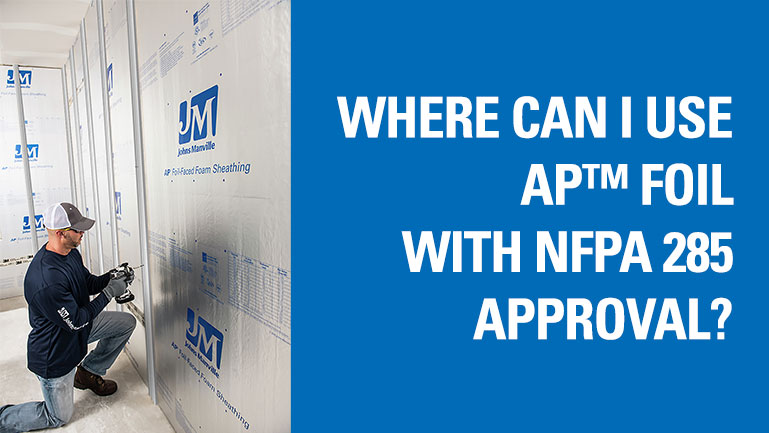Polyiso board insulation offers one of the highest R-values per inch of any insulating material available to the commercial market, making it an attractive option for many builders. However, unlike fibrous insulations such as mineral wool or fiberglass that are inherently non-combustible, polyiso is a plastic foam, making it more likely to burn. As a result, one of the most common questions we get about our polyiso boards, AP™ Foil-Faced Foam Sheathing and CI Max®, is whether or not it can be used in a
non-combustible or rated wall assembly.
To navigate this question, we must first explore how insulation materials are tested for fire resilience. Since exterior insulation, like AP™ Foil-Faced Foam Sheathing or CI Max®, is not the only component in a wall system, the material must be tested as part of a complete wall assembly using the NFPA 285 test method. This helps ensure that the material is tested in the same manner that it would be installed and used in a real-world application. The objective of this test is to evaluate how well exterior wall assemblies with combustible components can resist flame spread. The goal is to ensure that buildings will be built in a manner that limits flame propagation through the exterior wall of a building during a fire.
The NFPA test exposes complete wall assemblies to controlled flames to explore how quickly and under what conditions the flame spreads through the assembly. During this test, researchers look not only at how far the flames spread but also at how the wall components are impacted by the flames as well as the temperature rise within the assembly. They are looking to verify that the insulation material, as well as the wall components, remain mostly intact with minimal melting or charring.
AP™ Foil-Faced Foam Sheathing and CI Max have each been approved for use in 9 different wall cladding assemblies. During the NFPA 285 testing, 3.5” of AP™ Foil-Faced Foam Sheathing or 3.5” of CI Max was installed as continuous insulation for use under the cladding systems listed below:
- Brick: Standard 4 inch thick
- Stucco: Minimum ¾ inch thick
- Stone Veneer: Minimum 2-inch thick; limestone or natural stone veneer
- Terra Cotta Cladding: Minimum 1 ¼ inch thick; any terracotta cladding system
- Precast Concrete Panels or Concrete Masonry Unit (CMU): Minimum 1 ½ inch thick
- NEW Autoclaved-Aerated Concrete (AAC) panels
- NEW Thin Brick System: Minimum ¾-inch thick
- NEW Uninsulated Fiber Cement Board: Minimum ¼-inch thick
- NEW Solid Metal Panels: Minimum 3-mm thick; steel, aluminum, copper, etc.
The test assembly was constructed and tested first with the weakest exterior cladding system: 3mm thick aluminum panels. An engineering judgment was then made by a qualified, third-party engineering testing firm to include additional approvals for systems with comparable or lesser (better performing) fire propagation characteristics. This is industry standard practice for developing a greater scope for each assembly test. The objective is to afford designers the widest palette of materials to use with a significant safety factor applied.
AP™ Foil-Faced Foam Sheathing and CI Max exceeded all NFPA 285 test requirements. As a result, we can confidently say that using JM’s polyiso insulation boards as one of the components in an NFPA 285 tested and approved wall assembly, will meet the most restrictive commercial building code requirements.
This testing allows building designers to capitalize on the excellent insulating properties of polyiso insulation boards under a variety of different exterior veneers, including solid metal panels, with the knowledge that they will be in full compliance with the latest building fire codes. As designers and architects look for new ways to improve building efficiency, materials with exceptional
R-values, like polyiso insulation boards, will help pave the way for more energy-efficient structures. By using tests like NFPA 285, we can help build safer wall assemblies that help maximize the energy efficiency of the building.
For more information about NFPA 285 approved wall assemblies, please visit NFPA.org.

